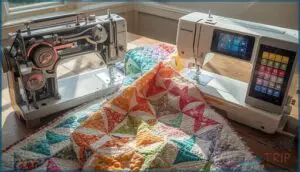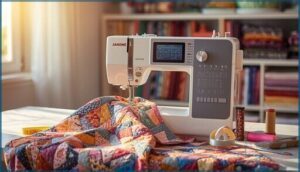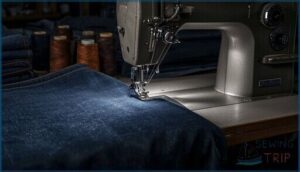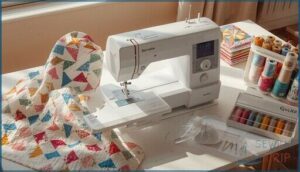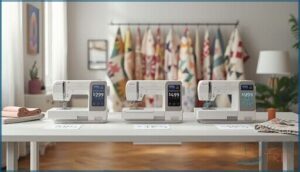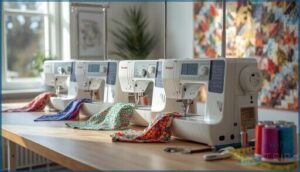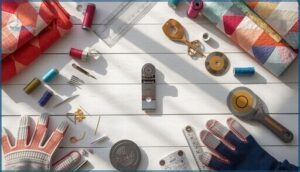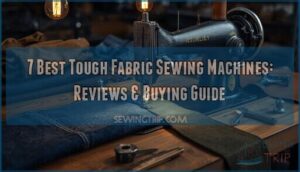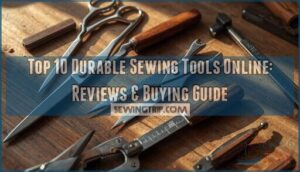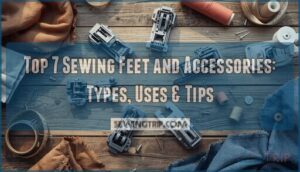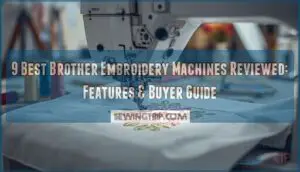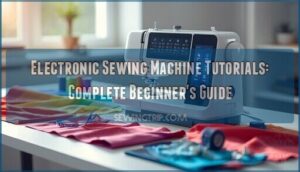This site is supported by our readers. We may earn a commission, at no cost to you, if you purchase through links.
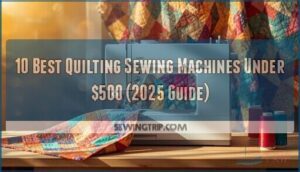
The catch isn’t in the price tag, it’s in knowing which budget-friendly machines deliver on their promises and which ones will leave you fighting with tension issues halfway through your first bed quilt.
Whether you’re piecing your first lap quilt or tackling king-sized projects, the right affordable machine can manage the workload without compromise.
Table Of Contents
- Key Takeaways
- Best Quilting Sewing Machines Under $500
- 1. Brother CS6000i Sewing Quilting Machine
- 2. Brother CS7000X Sewing Quilting Machine
- 3. Brother XR3774 Sewing Quilting Machine
- 4. Brother HC1850 Sewing Quilting Machine
- 5. SINGER Quantum Stylist 9960 Sewing Machine
- 6. Juki HZL F600 Sewing Quilting Machine
- 7. JUKI TL-2000Qi Sewing Quilting Machine
- 8. Janome MC6650 Sewing Quilting Machine
- 9. Bernette B77 Sewing Quilting Machine Bundle
- 10. Brother PQ1600S Sewing Quilting Machine
- Key Features to Look for in Quilting Machines
- Mechanical Vs. Computerized Quilting Machines
- Comparing Popular Quilting Machine Brands
- How Much Does a Quilting Machine Cost?
- Choosing The Right Machine for Your Projects
- Tips for Buying Quilting Machines Online
- Essential Accessories for Quilting Machines
- Maximizing Value on a Budget
- Frequently Asked Questions (FAQs)
- Conclusion
Key Takeaways
- Quality quilting machines under $500 now include features like extended throat space, built-in walking feet, and high-speed stitching that used to be exclusive to premium models, making capable machines accessible without requiring a four-figure investment.
- The choice between mechanical and computerized quilting machines depends on your priorities—mechanical models offer simpler repairs and lower costs (often under $300), while computerized versions provide precise stitch customization, automatic tension adjustment, and memory functions that streamline repetitive tasks.
- Brother dominates the budget-friendly quilting market with models like the CS6000i and PQ1600S that balance affordability with features such as 60+ built-in stitches, automatic needle threaders, and 25-year warranties, though specialized brands like Juki excel at handling heavy fabrics and thick layers.
- Smart buyers can maximize value by timing purchases around seasonal sales (20-40% discounts), considering refurbished machines (30-50% savings), and evaluating which features matter most for their actual projects—throat space and stitch quality typically offer better long-term value than decorative stitches you rarely use.
Best Quilting Sewing Machines Under $500
Finding a solid quilting machine under $500 means balancing features, workspace, and reliability without breaking the bank. The machines on this list offer the throat space, stitch variety, and durability you need to tackle quilt projects with confidence.
Here’s a closer look at ten models that deliver real value for hobbyists and serious quilters alike.
1. Brother CS6000i Sewing Quilting Machine
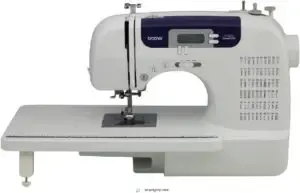
The Brother CS6000i stands out as one of the best quilting machines under $500, combining beginner friendliness with impressive stitch variety. You’ll get 60 built-in stitches, including seven one-step buttonholes and specialized quilting patterns, all selectable through a backlit LCD screen.
This quilting sewing machine includes nine presser feet right in the box—covering everything from walking and quilting feet to zipper and monogramming attachments. The detachable wide table accommodates larger quilting projects beautifully, while the automatic needle threader saves your eyes and patience.
With 93% of users rating it four or five stars and a 25-year warranty backing the machine head, the CS6000i delivers outstanding long-term value and project versatility for both beginners and experienced sewers.
Best For: Beginners and experienced sewers looking for an affordable, feature-rich quilting machine with a wide variety of stitches and accessories included.
- Comes with 60 built-in stitches and nine specialized presser feet, including walking and quilting feet, offering excellent versatility for various projects right out of the box.
- Automatic needle threader, LCD display, and detachable wide table make setup and operation straightforward for quilters of all skill levels.
- Outstanding long-term value with 93% user satisfaction rate, 25-year warranty on machine head, and proven durability for projects ranging from garments to king-sized quilts.
- Plastic construction may affect longevity compared to all-metal machines, with electronic components potentially having shorter lifespans.
- Included protective case is reported by some users as cheap and inadequate for regular transport.
- Only compatible with 120V AC power, limiting use in other countries even with voltage adapters.
2. Brother CS7000X Sewing Quilting Machine
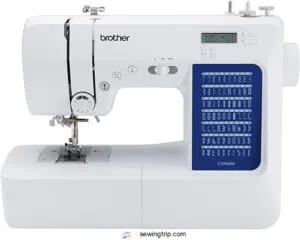
If you’re stepping up from the CS6000i, the Brother CS7000X offers 10 presser feet (including a walking foot), 70 built-in stitches, and a refined automatic needle threader—addressing one of the most requested upgrades. This quilting sewing machine delivers exceptional beginner friendliness with its LCD display and jam-resistant bobbin system, all while usually selling below $250 online.
You’ll appreciate the detachable wide table for larger quilts and the fixed needle bar that adds stability during intricate piecing. Brother backs it with a 25-year limited warranty and lifetime technical support, making it one of the best sewing machines under $500 for quilters seeking reliable stitch capabilities without stretching their budget.
Best For: Beginners and budget-conscious quilters who want a feature-rich machine with specialty feet and a wide workspace without spending over $250.
- Comes with 10 presser feet including a walking foot and quilting accessories, saving you from buying extras separately
- Improved automatic needle threader and jam-resistant bobbin system make setup easier than older Brother models
- 25-year warranty and lifetime support give you peace of mind for the long haul
- Sewing speed tops out at 750 stitches per minute, which is 100 slower than the CS6000i it replaced
- Only works with 120V US power, so you’ll need a converter if you’re using it elsewhere
- Some users report the automatic bobbin threader takes practice to get right
3. Brother XR3774 Sewing Quilting Machine
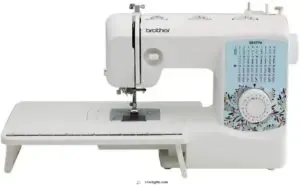
For a no-frills option among the best quilting machines under 500, the Brother XR3774 gives you 37 built-in stitches and a one-step buttonhole at a price point that won’t intimidate newcomers. Its value proposition centers on stitch variety and straightforward operation, though the smaller throat space means you’ll tackle lap quilts more comfortably than bed-size pieces.
This beginner quilting machine weighs just 12.3 lbs, making portability design a real strength when you’re moving between sewing spaces or attending workshops. You’ll find eight presser feet in the accessory pack, plus a wide table for medium-size projects, and the automatic needle threader saves time on setup.
Best For: Budget-conscious beginners who want a portable machine with good stitch variety for small-to-medium quilting projects without needing advanced features.
- At under $200, you get 37 stitches, automatic needle threader, and eight presser feet—solid value for the price point.
- Lightweight at 12.3 lbs with a portable design makes it easy to move between workspaces or take to classes.
- One-step buttonhole and straightforward mechanical controls let you start sewing without wrestling through complicated menus.
- Limited throat space restricts you to lap quilts and smaller projects—not ideal if you’re planning bed-size pieces.
- Only handles light-to-medium fabrics well; multiple layers of thick material can bog it down.
- No computerized features means you’ll manually adjust everything, which some users find less convenient than digital alternatives.
4. Brother HC1850 Sewing Quilting Machine
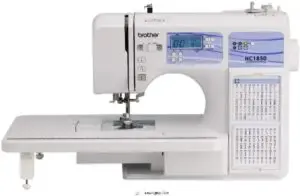
When you need more stitch variety than the XR3774 but want to stay budget-conscious, the Brother HC1850 quilting sewing machine delivers 185 built-in stitches and 55 alphanumeric characters for basic monogramming. This quilting machine balances beginner friendliness with expanded creative options, giving you room to grow without stretching your wallet beyond the best quilting machines under $500 threshold.
At 13.2 pounds, portability stays manageable for workshop trips, and the included wide table accommodates medium quilting projects comfortably. Fabric management covers light to medium-weight materials—think cotton, poplin, and denim with the right needle—while the 25-year warranty value backs your investment long-term.
Best For: Beginners and intermediate sewers who want extensive stitch variety and basic monogramming capabilities without spending over $500.
- 185 built-in stitches plus 55 alphanumeric characters give you tons of creative options for quilting, decorative stitching, and simple monogramming projects.
- Lightweight at 13.2 pounds with a built-in handle makes it easy to transport to classes or store away when not in use.
- Automatic needle threader and jam-resistant bobbin system minimize setup frustration, backed by a solid 25-year warranty.
- Only handles light to medium-weight fabrics—not suitable for heavy-duty materials or thick multi-layer projects.
- LCD display and computerized features may feel overwhelming if you’re just starting out and prefer simple mechanical controls.
- At around $250-$299, it’s pricier than basic models, though historical sales have dropped it to $139.99 if you catch a deal.
5. SINGER Quantum Stylist 9960 Sewing Machine
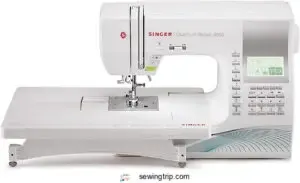
If sheer stitch variety tops your priority list, the SINGER Quantum Stylist 9960 sewing machine packs 600 built-in stitches—more than any competitor among best sewing machines under 500.
This quilting sewing machine includes 13 one-step buttonholes, five fonts for monogramming, and 18 presser feet, giving you serious quilting accessories right out of the box. User automation shines through the automatic needle threader and thread cutter, cutting setup time when you’re layering quilt blocks.
Machine reliability holds steady thanks to a metal frame, and market value stays competitive around $570-$586, though you’ll find it closer to the upper boundary of best quilting machines in this price range.
Best For: Sewers who want the widest stitch selection available and value built-in automation features for quilting and decorative projects.
- 600 built-in stitches with 5 fonts and 13 buttonhole styles give you unmatched creative options in this price range
- 18 included presser feet and a wide extension table make it ready for quilting right out of the box
- Automatic needle threader and thread cutter save time and reduce eye strain during long sewing sessions
- Price sits at the upper end of the under-$500 category, typically around $570-$586
- Learning curve can be steep with so many features—expect to spend time with the manual and tutorials
- Self-threader takes practice to master, which some beginners find frustrating at first
6. Juki HZL F600 Sewing Quilting Machine
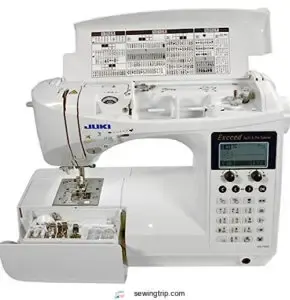
When Stitch Versatility meets industrial-grade build, the Juki HZLF600 stands out among the best sewing machines under $500—though it’s priced at $1,399-$1,499. This quilting machine offers 225 built-in stitches and sews up to 900 stitches per minute, tackling everything from silk to thick denim thanks to its Material Handling prowess with a 7-point steel feed dog.
Quilting Features include an 8-inch throat space, extension table, and knee lifter for hands-free control.
Automation Controls like automatic needle threading and tension adjustment save you time, while the Durability Pricing reflects its all-metal frame construction built for years of quilting projects.
Best For: Quilters and serious sewers who need industrial-grade performance, extensive stitch options, and automated features for handling complex projects from delicate fabrics to thick layers.
- 225 built-in stitches with 900 stitches per minute speed and versatile 7-point feed system handles everything from silk to heavy denim
- Quilting-optimized design with 8-inch throat space, extension table, knee lifter, and walking foot for professional-level quilt projects
- Time-saving automation including automatic needle threading, tension control, and thread cutting with durable all-metal frame construction
- Priced at $1,399-$1,499, significantly higher than basic machines and not truly under $500 as the context suggests
- Instruction manual reported as difficult to follow, and some users experienced quality control issues with parts like screws and the automatic needle threader
- Can be loud when sewing thick fabrics and may struggle with extremely heavy materials like four layers of denim
7. JUKI TL-2000Qi Sewing Quilting Machine
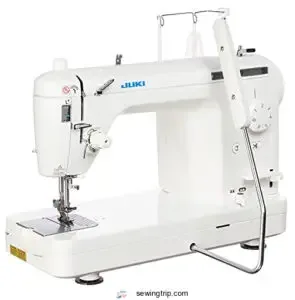
When you want Industrial Build quality without the longarm footprint, the Juki TL2000Qi delivers serious quilting power. This straight-stitch sewing machine runs at 1,500 stitches per minute, managing thick layers and free-motion work with its aluminum die-cast frame that keeps vibration low.
The 8.5-inch throat and 23-inch extension table give you room to move, while the automatic needle threader and knee lifter add User Convenience for long sessions.
At $750-$1,700, its Value Proposition shines through a 5-year mechanical warranty and Maintenance Tips you can take care of yourself—just regular cleaning and oiling keep this quilter running strong.
Best For: Quilters and serious sewers who want industrial-grade speed and durability for handling thick fabrics and large projects without investing in a longarm machine.
- Blazing fast at 1,500 stitches per minute with a rock-solid aluminum frame that keeps vibration minimal during heavy-duty work
- Generous 8.5-inch throat space and 23-inch extension table give you plenty of room to maneuver large quilts
- Strong 5-year mechanical warranty and easy DIY maintenance make it a reliable workhorse that won’t need constant professional servicing
- Only does straight stitches, so you’ll need a second machine if you want decorative or zigzag stitches
- Weighs 25 pounds, which means you’re not moving it around easily without help
- Some specialty feet like free-motion or quarter-inch quilting feet cost extra and aren’t included in the box
8. Janome MC6650 Sewing Quilting Machine
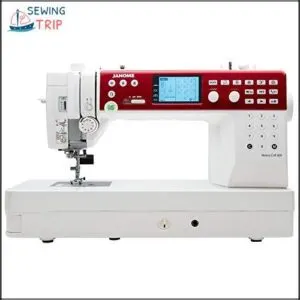
At $1,999, the Janome MC6650 stretches beyond budget-friendly territory, yet its build quality earns serious respect—an all-metal unified 10-inch flatbed and aluminum frame bear heavy quilting layers without flexing.
You get 170 stitch functions plus two alphabets, memorized needle up/down for pivoting corners, and automation features like an excellent threader and programmable thread cutter that save time on long sewing sessions.
Included accessories cover twelve presser feet, two needle plates with one-push conversion, and a removable stitch chart.
Warranty details offer 25 years on mechanical parts, five on electronics, and one year of labor—protection that backs your investment.
Best For: Serious quilters and advanced sewers who need professional-grade automation, a wide stitch library, and a durable machine built to handle heavy daily use.
- All-metal construction with a 10-inch flatbed handles large quilts without flexing, backed by a 25-year mechanical warranty
- 170 stitches plus automated features like superior needle threader and programmable thread cutter streamline repetitive tasks
- Twelve included presser feet and one-push needle plate conversion system eliminate the need for additional purchases
- $1,999 price point puts it out of reach for casual hobbyists or beginners on a tight budget
- Some users report occasional stitch skipping and thread cutter malfunctions that may require servicing
- Instruction manual lacks clarity, which can frustrate new owners trying to master advanced features
9. Bernette B77 Sewing Quilting Machine Bundle
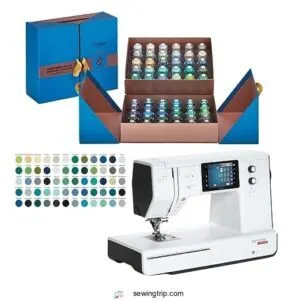
Bundle value hits hard when quilting machine cost worries you, and the Bernette B77 delivers 500 stitches plus an automatic thread cutter, dual feed for layer control, and a programmable foot pedal alongside a 60-piece accessory set. Its large extension table accommodates bulky projects without crowding, while eight presser feet tackle varied fabrics.
Some users report stitch securing feels loose and customer support lags, so test tension settings early.
At its price point, this sewing machine balances quilting machine features with practical extras that stretch your dollar.
Best For: Quilters and sewers who want solid features like 500 stitches, dual feed, and an automatic thread cutter without breaking the bank, especially if you’re comfortable troubleshooting tension settings.
- Comes loaded with 500 stitches, dual feed for managing multiple layers, automatic thread cutter, and a programmable foot pedal that gives you precise control
- Includes 60-piece thread bundle, eight presser feet, and a large extension table so you can tackle big quilts or bulky projects right out of the box
- Handles everything from delicate fabrics to leather, making it versatile for clothes, quilts, and accessories
- Stitch securing can feel loose on some projects, so you’ll need to dial in your tension settings early to avoid frustration
- Customer support reportedly lags, which means you might be on your own if the motor or thread cutter acts up
- No automatic thread tension adjustment, so beginners may face a learning curve getting consistent results
10. Brother PQ1600S Sewing Quilting Machine
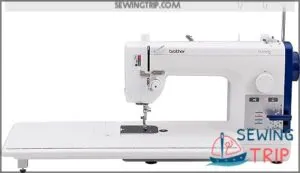
High-speed stitching peaks at 1,500 stitches per minute with the Brother PQ1600S, a straight-stitch specialist that dominates quilting machine reviews for free-motion work. Its pin feed system grips thick layers, the included knee lifter frees both hands, and seven quilting feet tackle varied tasks.
Thread tension adjusts via a visible dial, while the extension table expands your workspace to 11.1″ × 23.3″.
Some users note the side-loading bobbin lacks a thread-out alert and the needle threader balks at budget thread. At its quilting machine cost, this Best Sewing Machines pick suits experienced sewists chasing speed and precision.
Best For: Experienced quilters and sewists who need a high-speed straight-stitch machine for large projects and free-motion quilting.
- Blazing fast at 1,500 stitches per minute with reliable pin feed system for thick layers
- Huge workspace (11.1″ × 23.3″ table) plus knee lifter and 7 specialty feet included
- Simple tension adjustments and feed dog controls make it easy to dial in perfect stitches
- Side-loading bobbin doesn’t warn you when thread runs out, which can interrupt your flow
- Needle threader struggles with budget thread and can be finicky to use
- Not beginner-friendly—this machine assumes you already know your way around quilting basics
Key Features to Look for in Quilting Machines
Not every quilting machine under $500 is built the same, and certain features make a real difference when you’re working through layers of fabric and batting.
Knowing what to prioritize helps you avoid machines that look good on paper but fall short at the sewing table. Here’s what separates a capable quilting machine from one that’ll leave you frustrated.
Extended Throat Space and Workspace
When you’re piecing together a king-size quilt, the last thing you need is fabric bunching up because your machine’s throat space feels like trying to thread a camel through the eye of a needle. Extended throat space gives you room to maneuver bulky projects without fighting the fabric every inch of the way.
Look for these workspace features in budget-friendly quilting machines:
- 7+ inches of throat space for controlling larger quilt sections comfortably
- Extension tables that expand your work surface for better fabric control
- Flat-bed design that props up heavy quilts and prevents drag
- Free-arm access when you need to tackle sleeves or circular sections
- Stable base that won’t wobble when managing thick layers
This workspace ergonomics directly affects your quilting comfort and maneuverability benefits, especially on projects that push your machine’s limits.
Built-in Quilting Stitches
Your machine’s stitch library matters just as much as the space you have to work with, since different quilting patterns demand specific stitch types to hold layers together or add decorative touches. Beginner quilting machines should offer at least 50 builtin stitches with solid stitch quality, including utility, decorative options, and specialized quilting stitches like stippling or echo patterns.
Stitch variety gives you stitch customization freedom for different stitch applications, whether you’re piecing blocks or adding finishing flourishes.
Walking Foot and Free-motion Capability
Once you’ve got the right stitches, you need the proper foot to keep all those quilt layers moving evenly through your machine without bunching or shifting.
A walking foot feeds thick fabric layers smoothly, preventing puckering during straight-line quilting, while free-motion quilting capability lets you drop the feed dogs for creative freedom with stippling and custom quilting designs—both essential foot types for beginner quilting machines in budget-friendly price ranges.
Automatic Needle Threader and Speed Control
Threading needles under harsh lights while squinting at tiny eye holes is nobody’s idea of a good time, which is why automated needle threaders and variable speed controls have become two of the most requested features on machines under $500.
A reliable automatic needle threader saves your eyes and patience, especially important for beginner-friendly models, while adjustable speed control lets you customize motor performance from slow precision work to faster straight seams on budget-friendly sewing machines.
Accessory Compatibility and Extension Tables
Most quilting machines won’t reach their full potential unless you pair them with the right add-ons, and extension tables top the list for anyone working with bed-sized projects.
Check foot compatibility before buying accessories, since some brands limit third-party options, and verify table stability for your extended workspace.
Budget-conscious quilters often build DIY tables with plywood and clamps, gaining the wide table benefits without breaking the bank on sewing machine accessories.
Mechanical Vs. Computerized Quilting Machines
When you’re shopping for a quilting machine under $500, you’ll need to choose between mechanical and computerized models. Each type has distinct strengths that affect how you’ll work with fabrics, adjust settings, and complete your projects.
Here’s what separates these two approaches and how each one fits different quilting styles.
Benefits of Mechanical Quilting Machines
Mechanical quilting machines don’t rely on computers or circuit boards, which means fewer parts that can break down and simpler repairs you can often manage yourself. They’re also budget-friendly, with many beginner quilting machines priced well under $300. The straightforward controls make them beginner-friendly since there’s no learning curve for digital menus or settings.
| Feature | Why It Matters |
|---|---|
| Affordable Quilting | Keeps your quilting machine cost low without sacrificing durability |
| Simple Operation | Dial-and-stitch controls feel natural from day one |
| Durable Build | Metal frames and mechanical parts last for decades |
| Repair Ease | You can troubleshoot and fix most issues at home |
Advantages of Computerized Quilting Machines
Computerized quilting machines bring precision and convenience that can transform hours of repetitive tasks into simple automation, making complex patterns feel surprisingly manageable.
These computerized sewing machines offer automatic tension adjustment, hundreds of built-in stitches, and memory functions that store your favorite settings. You’ll find features like touchscreen displays and USB connectivity that let you download fresh patterns without leaving your sewing room.
| Feature | Why It Matters |
|---|---|
| Stitch Precision | Consistent tension and spacing across every seam |
| Pattern Customization | Edit, mirror, and combine designs on-screen |
| Automation Benefits | Needle threaders and thread cutters save time daily |
Precision and Customization Options
When you can tweak stitch length down to the millimeter or mirror a pattern with one button, you’re not just sewing—you’re designing on the fly. Computerized quilting machines let you adjust needle positioning, fine-tune tension control, and create custom patterns that mechanical models can’t match. Budget-friendly machines now include stitch options and adjustable speed control that once cost thousands.
| Customization Feature | Mechanical Limit | Computerized Advantage |
|---|---|---|
| Stitch Length | Manual dial adjustment | Precise digital increments |
| Pattern Creation | Fixed built-in designs | Edit, combine, save patterns |
| Needle Positioning | Basic left/center/right | Infinite placement points |
| Feed System Control | Static feed dogs | Programmable feed rates |
Ease of Use for Beginners and Pros
If you’re just starting out, automated features feel like training wheels you’ll actually appreciate, while pros will value shortcuts that don’t compromise control. Beginner sewing machines with easily grasped designs reduce the learning curve—computerized models guide you through stitch selection on-screen, while mechanical machines keep things affordable with straightforward user manuals. Maintenance ease matters for both skill levels.
| User Level | Best Machine Type |
|---|---|
| Beginners | Computerized with easy-to-use features |
| Intermediate | Either, based on project needs |
| Pros | Mechanical for speed, computerized for creativity |
Comparing Popular Quilting Machine Brands
When you’re shopping for a quilting machine under $500, the brand you choose can make a real difference in how your machine performs and holds up over time. Each major manufacturer brings something different to the table, whether it’s reliability, inventive features, or sheer stitching power.
Let’s look at what Brother, Singer, Janome, Juki, and Bernette each do best so you can find the right fit for your quilting style.
Brother Quilting Machine Strengths
Brother has built a reputation among quilters by consistently delivering machines that punch above their weight, offering features usually found in pricier models while keeping prices accessible for hobbyists and serious crafters alike.
Their models like the Brother PQ1600S, XR3774, and HC1850 showcase excellent stitch variety and user-friendliness that beginners appreciate. You’ll find automatic needle threaders, wide throat space, and reliable performance across their lineup.
This feature integration makes Brother a go-to choice when affordability meets dependable quilting machine quality.
Singer Reliability and Affordability
Singer has been earning quilters’ trust for over a century, and their modern machines like the Quantum Stylist 9960 prove that legacy brands can still deliver impressive value without draining your wallet.
With 600 built-in stitches and beginner-friendly controls, the Singer 9960 stands out as budget-friendly without sacrificing durability. You’ll find lower repair costs compared to newer brands, making this quilting machine a smart long-term investment for mastering your craft.
Janome Innovation and Versatility
Janome machines pack serious tech into surprisingly accessible packages, especially if you’re juggling multiple fabric weights or want room to grow beyond basic piecing.
The Janome MC6650 delivers superb stitch quality with precise tension control, earning a strong brand reputation among quilters who value reliability.
Budget-friendly models like the JW8100 offer user experience improvements—automatic threading, adjustable speed—that make learning less frustrating without pushing your average cost of quilting machines beyond reach.
Juki Performance for Heavy Fabrics
Juki builds machines that power through denim, canvas, and layered quilt sandwiches without the motor strain or skipped stitches you’ll see on lighter-duty models. The Juki TL-2000Qi and HZL-F600 showcase industrial-strength stitching and durable machine build that tackle quilting thick layers effortlessly.
Key strengths include:
- Juki motor power that maintains consistent speed under load
- Juki fabric control designed for heavy-duty sewing machines
- Budget-friendly sewing machine cost for quilting performance
- Material quality that outlasts lightweight competitors
Bernette Value Bundles
Bernette bundles throw in extension tables, presser feet, and accessory kits that would cost you another $100 to $200 if you bought them separately.
The Bernette B77 offers beginner-friendly features, impressive stitch variety, and long-term value that makes it one of the smartest quilting machine investments under $500. You’re getting a capable sewing machine with everything you need to start quilting right away.
How Much Does a Quilting Machine Cost?
Quilting machine prices vary widely depending on features, brand, and whether you’re shopping online or in-store. Understanding the price ranges helps you set realistic expectations and find the best value for your budget.
Let’s break down what you can expect to pay at different price points and what factors influence the cost.
Entry-level Pricing Under $300
Entry-level quilting machines under $300 put you in the game without draining your wallet, offering mechanical reliability and enough features to tackle most beginner and intermediate projects.
You’ll find budget-friendly models around $129 to $299 that perform basic quilting tasks, though they usually lack sophisticated automation and may have smaller workspaces.
These mechanical machine benefits include straightforward operation and fewer repair headaches, making them smart choices when you’re evaluating value and testing the waters.
Mid-range Machines and Their Features
Step up to the $899 median price point, and you’re rewarded with enhanced functionality that bridges the gap between basic stitching and the automation you’d find in premium models.
You’ll gain wider workspace size for bulky quilts, stitch variety in the hundreds, speed control that adjusts to intricate piecing, and durability factors built for consistent use.
Feature prioritization matters here—these quilting machines deliver machine versatility without overloading you with bells and whistles you won’t use.
Price Differences: Online Vs. Retail
Where should you shop for quilting machines? Online discounts average 10–22% lower than brick-and-mortar shops, plus flash sales can drop prices another 8–15%. But in-store promotions at quilt shows sometimes slash $300–$2,500 off premium models. MAP policies keep certain brands uniform across channels, yet regional variability means local dealers negotiate differently.
Compare both—bundled packages and free shipping shift quilting machine cost in surprising ways. For quilters looking for versatility, the Baby Lock Chorus offers an 11.25-inch workspace.
Factors Affecting Quilting Machine Prices
Why do two machines with identical stitch counts carry price tags $200 apart? Throat space, motor type, metal frame construction, and bundled accessories all shift the final number—sometimes more than brand name alone.
Manufacturing location, material costs, and feature complexity—like automatic needle threaders or LCD displays—add layers to quilting machine cost.
Brand reputation drives market demand, which is why budget-friendly models from established names often outperform used machine costs.
Hunt for quilting machine deals that balance factors affecting quilting machine prices with your actual stitching needs.
Choosing The Right Machine for Your Projects
Choosing the right quilting machine means matching its features to the work you actually do. The throat space, stitch variety, and fabric management capabilities need to align with your projects, whether you’re piecing small blocks or quilting full-sized bedspreads.
Here’s how to evaluate your needs and find the best fit for your budget.
Matching Machine Features to Quilting Needs
Your quilting style—whether you stitch delicate patchwork, piece together bold geometric designs, or work with heavy batting—dictates which machine features actually matter. If you’re piecing small blocks, stitch variety and precision trump throat space, while large project sizes demand extended workspace.
Match quilting machine features to your skill level and budget constraints—beginners benefit from automatic needle threaders, whereas experienced quilters prioritize speed control for intricate free-motion work, ensuring your sewing machine cost for quilting reflects true value.
Selecting for Fabric Types and Thickness
Thick batting, slippery satins, and stiff denims don’t all play nice with the same machine—your fabric choices determine whether you need a workhorse motor or just consistent stitch control. Best Sewing Machines for heavy duty fabric management include:
- High-torque motors that push through layered batting without stalling
- Adjustable presser foot pressure for gentle satin or firm denim grip
- Metal feed mechanisms that grab thick layers evenly
- Tension adjustment tips to prevent puckering on delicate weaves
- Needle size matters—switch from 80/12 for cotton to 100/16 for canvas
Heavy duty machine features prevent skipped stitches when layering fabrics guide multiple thicknesses under the foot.
Versatility for Sewing and Quilting Tasks
Once you’ve matched your machine to your materials, you’ll want a model that addresses garment hems on Monday and quilt blocks by Thursday without needing a second setup.
Look for beginner quilting machines offering stitch variety—utility stitches for garments, decorative stitches for creative applications, and quilting-specific patterns for piecing.
Fabric control versatility means the same sewing machine deals with cotton seams and layered batting equally well, supporting project diversity across skill levels without constant adjustments.
Prioritizing Features for Beginners and Experts
Beginners need machines that won’t punish mistakes, while experienced quilters want speed and fine control—knowing which features matter most to your skill level helps you skip paying for tools you’re not ready to use.
Beginner essentials include automatic needle threaders, clear stitch selection, and forgiving speed control on budget-friendly machines. Expert upgrades focus on faster stitching speeds, precise tension adjustments, and expanded throat space for handling complex projects. Feature trade-offs become clearer when you assess your skill level: beginners benefit more from built-in tutorials and beginner quilting machines with straightforward controls, while experienced sewers prioritize quilting machine features that improve efficiency over hand-holding.
- Automatic needle threader – Essential for beginners, convenient for experts
- Variable speed control – Builds confidence at any skill level
- Stitch memory and customization – Grows with advancing technique
- Extended throat space – More valuable as project complexity increases
Tips for Buying Quilting Machines Online
Shopping for a quilting machine online can save you money, but it requires some careful attention to detail. You’ll want to make sure you’re getting the right machine from the right seller, with proper support after the sale.
Here’s what you need to focus on before clicking that checkout button.
Identifying Trusted Sellers and Platforms
When buying quilting machines online, you’ll want to stick with sellers who have solid track records. Check if they’re certified dealers for brands like Brother, Janome, or Juki, since only 5.4% of quilters considered their retailer truly trusted in recent surveys. Look for consistent ratings above 4.5 out of 5, clear return policies, and detailed product specs. Tools like Fakespot can help you spot suspicious reviews, while platforms following the INFORM Consumers Act verify seller identities. Watch for marketplace fraud, which averages 5% during growth periods, and prioritize sellers bundling genuine accessories with machines. The market’s growth is significant, with projections estimating it will reach $443.4 million by 2032.
| Trust Signal | What to Look For | Red Flag |
|---|---|---|
| Review authenticity | 4.5+ stars with verified purchases | Sudden rating spikes or generic praise |
| Seller certifications | Authorized dealer status, brand training | No certification or vague credentials |
| Return policies | Clear terms, 30+ day windows | Hidden fees or restocking charges |
| Warranty extensions | Manufacturer-backed support | Third-party only or no coverage |
| Shipping costs | Free shipping options, tracking | Unexplained surcharges or delays |
Checking Warranty and Customer Support
A solid warranty backed by responsive customer support can save you hundreds of dollars and weeks of frustration if something goes wrong with your machine. Here’s what matters when evaluating coverage for quilting machines:
- Warranty length – Look for 25-year limited warranties on mechanical parts, with 1-2 years on electrical components
- Support channels – Verify phone, email, and live chat availability during your working hours
- Repair options – Confirm authorized service centers exist near you or if mail-in repairs are covered
- Parts availability – Check that replacement parts stay stocked for at least 10 years after purchase
- Online resources – Access to video tutorials and troubleshooting guides extends your machine’s lifespan
Many retailers offer warranty extensions at checkout, but compare costs against manufacturer customer service records first.
Finding Discounts, Bundles, and Free Shipping
Smart shoppers can trim 10% to 25% off the sticker price by timing their purchase right and hunting down package deals that include essential accessories. Check for discount codes at checkout, set price alerts on comparison sites, and target seasonal sales around Black Friday or quilting month.
Most retailers now offer free shipping on orders over $50, lowering your quilting machine cost considerably. Budget-friendly bundle deals often include walking feet and extension tables worth $100 or more, and financing options let you spread payments over 6-12 months interest-free.
Essential Accessories for Quilting Machines
Getting the most from your quilting machine often means adding the right extras to your setup. A few key accessories can improve your stitching quality, expand your project possibilities, and keep your machine running smoothly for years.
Here’s what you should consider adding to your workspace.
Extension Tables and Quilt Frames
When you’re piecing together a bed-sized quilt, running out of workspace is like trying to fold a map in a moving car—it just doesn’t work. Extension tables give quilting machines the extended workspace you need to hold up fabric without wrestling gravity. Here’s what matters when choosing one:
- Table Stability: Look for solid frame materials that won’t wobble mid-seam
- Extended Throat Space: Wide tables pair with machines offering generous throat clearance for bulky layers
- Portability Options: Folding tables work if you’re short on space but need quilting cabinets occasionally
- DIY Frames: Budget-conscious quilters often build custom frames using plywood and adjustable legs
- Ergonomic Benefits: Proper height reduces shoulder strain during long sessions
Walking Foot and Specialty Presser Feet
Without the right presser foot, quilting through multiple fabric layers is like pushing a wheelbarrow uphill with a flat tire—you’ll get there, but you won’t enjoy the trip. A walking foot keeps fabric layers moving together, preventing shifting and puckering that plague beginner quilting machines.
Budget-friendly sewing machines often include basic feet, but specialty presser feet improve fabric feed control and even stitching dramatically. Check foot compatibility before purchasing quilting machines—mismatched shanks mean wasted money.
Needles and Thread for Quilting
The needle-and-thread pairing you choose determines whether your quilting machine glides through layers smoothly or struggles with skipped stitches and broken threads. Quilter’s needles (size 90/14) manage thick batting without needle breakage, while cotton thread in 40-weight provides strength and flexibility for sewing through multiple fabric layers.
Match thread weight to fabric thickness—heavier weaving requires sturdier thread—and adjust thread tension settings to prevent thread breakage and puckering.
Maintenance Kits and Storage Solutions
Regular cleaning and proper storage aren’t optional—they’re what keep your quilting machine running like new instead of collecting dust in a corner. A basic maintenance kit with cleaning supplies, oiling techniques guidance, and lint brushes meets your machine’s maintenance needs between projects.
Invest in dust covers for protection, organize needle storage by size, and create workspace organization systems for your quilting supplies—these small steps protect your investment without inflating your quilting machine cost.
Maximizing Value on a Budget
Getting the most machine for your money means knowing where to look and when to buy. You don’t have to pay full retail price to get a reliable quilting machine that’ll serve you well for years.
Here’s how to stretch your budget without sacrificing the features you actually need.
Financing and Installment Options
Many quilters don’t realize that breaking up the total cost into monthly payments can make even top-tier machines under $500 feel like loose change in your fabric budget.
Retailers like Amazon and authorized dealers offer payment plans through Affirm or PayPal Credit, often with zero-interest financing options for budget-friendly purchases.
These credit options and easy installments turn smart purchasing decisions into reality, helping you choose an affordable device without draining your savings all at once.
Taking Advantage of Seasonal Sales
Beyond payment plans, timing your purchase around Black Friday, Cyber Monday, or spring clearance events can shave an extra 20–40% off machines that already fit your budget. Retailers slash prices on beginner quilting machines during these holiday sales, and price tracking tools help you spot when your dream model hits rock bottom.
Keep an eye on discounts and sales on quilting machines throughout the year—choosing an affordable device becomes easier when you know quilting machine costs usually drop during these key windows.
Evaluating Refurbished and Open-box Deals
Refurbished and open-box quilting machines let you stretch your dollar even further. You’ll usually find excellent value with refurbished units priced 30–50% below new models, while open-box versions offer 10–25% savings.
Before you commit, check warranty coverage—most refurbished machines include 90 days to one year of protection. Inspect the condition carefully, test stitch quality, and confirm all accessories are included to avoid hidden costs down the road.
Balancing Price, Features, and Long-term Use
Finding that ideal balance between what you can afford today and what you’ll actually need six months from now takes a little forward thinking. Here’s how to balance budget-friendly choices with long-term value:
- Prioritize upgradeability—choose a sewing machine with accessory compatibility so you can add specialty feet and extension tables as your skills grow.
- Assess feature longevity—invest in core capabilities like throat space and stitch quality over decorative stitches you might rarely use.
- Consider skill progression—beginner quilting machines under $300 work fine initially, but mid-range models around $400–$500 offer better value retention if you’re committed.
- Calculate true quilting machine cost—factor in thread, needles, and maintenance to avoid budget surprises down the road.
Frequently Asked Questions (FAQs)
How much does a quilting machine cost?
Quilting machine costs can range from jaw-droppingly affordable to seriously premium pricing. Entry-level beginner quilting machines start under $300, while mid-range models hover around $899, offering budget-friendly options for most sewers.
Used machine costs, maintenance expenses, and long-term investment value also matter.
Which sewing and quilting machine should I buy?
Your choice depends on skill level, project complexity, and budget constraints.
Match machine features like throat space and built-in stitches to your quilting needs, considering fabric thickness and space requirements while reviewing quilting machine reviews.
What makes a good quilting machine?
You can’t stitch together a quality quilt without the right foundation. Look for solid stitch quality, smooth fabric feed, proven machine durability, strong user friendliness, and thoughtful feature balance when evaluating beginner quilting machines through quilting machine reviews.
Is a quilting machine a sewing machine?
Yes, a quilting machine is a sewing machine, but it’s specialized for quilting tasks. You’ll notice differences in machine specialization like extended throat space, faster speed variation for working with thick fabric layers, and quilting add-ons like walking feet designed specifically for weaving through batting and multiple fabric layers.
What size is a quilting machine?
When sizing up your quilting machine, throat space matters most, ranging from 6 to 12 inches on most models under $ Extended throat space gives you room to maneuver larger quilts without constant repositioning.
Extension tables expand your work surface even further.
Which is the best computerized sewing machine?
Based on quilting machine reviews, Brother CS6000i earns top marks for computerized sewing machines under $500.
You’ll get feature prioritization through 60 built-in stitches, automation benefits like automatic needle threading, and solid stitch customization, balancing learning curve ease with long-term value.
What fabrics work best for beginner quilters?
Cotton fabrics with simple prints are your best starting point—they’re stable, forgiving, and work beautifully with budget-friendly beginner quilting machines. Precut fabrics like charm packs simplify cutting, while flannel softness adds texture without complications. Avoiding stretch materials keeps fabric weight manageable, preventing frustration as you master quilting basics.
How often should quilting machines be serviced?
You’ll want professional servicing every 12 to 18 months for heavy use, while light quilters can stretch to two years.
DIY maintenance between visits—cleaning lint, oiling, checking tension—keeps your quilting machine running smoothly and protects warranty coverage without constant trips to customer service.
Can quilting machines handle embroidery and appliqué?
Most machines that are capable of piecing can tackle appliqué with the right foot and fabric stabilization, but embroidery machines offer design complexity and stitch density that beginner quilting machines lack.
Budget-friendly models have machine limitations with thread compatibility for decorative work.
Whats the difference between throat space measurements?
You’ll find throat space measurements by checking the distance from the needle to the machine body—usually 6 to 9 inches on standard models.
Extended throat space quilting machines offer 10+ inches, giving you more room to maneuver bulky quilting projects without bunching.
Conclusion
Finding a quilting sewing machine at a low price doesn’t mean settling for second-rate results. The machines in this guide prove that capable stitching, manageable throat space, and reliable performance aren’t locked behind premium pricing.
Your first bed quilt or hundredth wall hanging deserves equipment that won’t quit halfway through—and now you know which models deliver. Match your project demands to the right features, take advantage of seasonal deals or bundles, and you’ll have a machine that works with layers without complaint.
Budget-conscious quilting starts with informed choices, not compromises.
- https://www.grandviewresearch.com/industry-analysis/sewing-machine-market-report
- https://www.mordorintelligence.com/industry-reports/sewing-machines-market
- https://www.bsewinn.com/blogs/inspiration/best-sewing-machine-for-quilting-beginners
- https://suzyquilts.com/quilting-sewing-machines-one-best-budget/
- https://www.walmart.com/browse/arts-crafts-sewing/quilting-sewing-machine/1334134_4770_8991465


